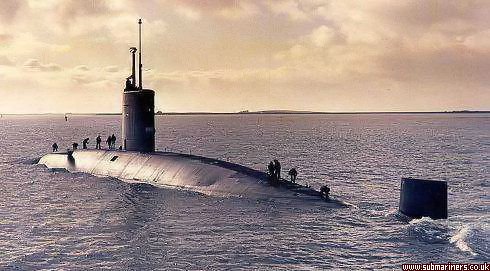La classe Churchill fu una classe di sottomarini d'attacco nucleari della Royal Navy, in servizio dagli anni settanta agli anni novanta; si trattava di un perfezionamento della precedente classe Valiant. La prima nave della classe venne battezzata in onore del precedente Primo Ministro del Regno Unito e Primo Lord dell'Ammiragliato, Winston Churchill.
Progettazione
Dopo lo HMS Dreadnought, che aveva introdotto i sottomarini nucleari nella Royal Navy, e la classe Valiant, la prima a montare motori nazionali britannici, con i sottomarini della classe Churchill si cercò di ottenere una silenziosità elevata, migliorando la sicurezza, la resa dei sensori e l'efficacia complessiva.
I sottomarini della classe Churchill portavano un equipaggio di 103 uomini e avevano un dislocamento a pieno carico in immersione di 4.900 t. Erano lunghi 86,9 metri, larghi 10,2 e pescavano 8,2. Il singolo reattore nucleare di cui erano dotati forniva vapore a due turbine English Electric, che producevano un totale di 20.000 CV per un singolo asse, permettendo di raggiungere una velocità massima di 28 nodi in immersione. Erano equipaggiati con un radar di ricerca di superficie Kelvin Type 1008, ed alla costruzione erano stati dotati di un impianto sonar Type 2001, che al finire degli anni settanta venne rimpiazzato da un impianto Type 202 e da un sensore trainato Type 2026.
Le armi erano le stesse della classe Valiant, come i siluri Mk 8 e Mk 23, ma presto si aggiunsero anche gli Mk 24 Tigerfish a doppio ruolo, seppur con alcuni difetti di affidabilità, e i missile antinave UGM-84 Harpoon.
Come per tutti i sottomarini nucleari potevano rimanere immersi per tempi praticamente indefiniti, limitati solo dalle provviste di viveri.
Le unità della classe:
- HMS Churchill (1965-1991);
- HMS Conqueror (1965-1991;
- HMS Courageus (1966-1990).
ENGLISH
The three Repeat Valiant-class submarines, sometimes known as the Churchill class, were nuclear-powered fleet submarines which served with the Royal Navy from the 1970s until the early 1990s. The Churchillclass was based on the older Valiant class, but featured many internal improvements.
The lead vessel was named after the former Prime Minister and First Lord of the Admiralty Winston Churchill. HMS Conqueror was the most famous of the class, sinking the Argentinian cruiser ARA General Belgranoduring the 1982 Falklands War. As of 2019, this is the only instance of a nuclear-powered submarine of any nation sinking an enemy ship by torpedo.
Design
The Churchills carried a crew of 103 and had a full load displacement of 4,900 tons whilst dived. They were 86.9 metres (285 ft 1 in) long, had a beam of 10.1 metres (33 ft 2 in) and a draught of 8.2 metres (26 ft 11 in). Their single pressurized water-cooled reactor supplied steam to two English Electric geared turbines, producing a total of 20,000 shaft horsepower (15,000 kW) for the single shaft and resulting in a maximum of 28 knots(52 km/h) submerged. Like all nuclear-powered submarines the Churchill class could remain submerged almost indefinitely, with supplies of food being the only limiting factor. One Kelvin Type 1006 surface-search radar was fitted. The ships were built with a Type 2001 sonar array, but this was replaced in the late 1970s with a Type 2020 array and a Type 2026 towed array. Weapons included Mk VIII torpedoes, Mk 24 Tigerfish torpedoes, and Sub-Harpoon anti-ship missiles. Six 21-inch (533 mm) torpedo tubes fired from the bow.
HMS Churchill evaluated both the American Mark 48 torpedo and the UGM-84 Harpoon missile, though only the latter was adopted by the Royal Navy. She was decommissioned in 1990 and is laid up at Rosyth awaiting disposal.
In 1981 HMS Courageous became the first British submarine to carry the Sub-Harpoon missile. She was decommissioned in 1992 and is at Devonport Dockyard serving as a museum ship.
Construction Programme:
- HMS Churchill (1965-1991);
- HMS Conqueror (1965-1991;
- HMS Courageus (1966-1990).
Service history
HMS Conqueror was the most famous of the class, sinking the Argentinian cruiser ARA General Belgrano during the 1982 Falklands War. She did not fire again during the war, but provided valuable help to the British task force by using her monitoring equipment to track Argentine aircraft departing the mainland. After the war Conqueror returned to Faslane; the sinking of General Belgrano had provoked controversy in Britain and Conqueror was criticised for flying the Jolly Roger on returning to port, as Royal Navy submarines customarily did on returning after scoring a kill. She is the only nuclear-powered submarine of any nationality to have engaged an enemy ship with torpedoes. She was decommissioned in 1990 and as of 2010 is laid up at Devonport awaiting disposal. Conqueror's periscopes can be viewed at the Royal Navy Submarine Museum in Gosport.
(Web, Google, Wikipedia, You Tube)






































Nessun commento:
Posta un commento
Nota. Solo i membri di questo blog possono postare un commento.